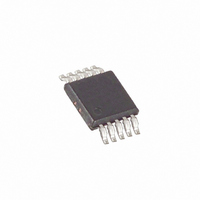MAX9700BEUB+T Maxim Integrated Products, MAX9700BEUB+T Datasheet - Page 10

MAX9700BEUB+T
Manufacturer Part Number
MAX9700BEUB+T
Description
IC AMP AUDIO 1.6W MONO D 10MSOP
Manufacturer
Maxim Integrated Products
Type
Class Dr
Datasheet
1.MAX9700DETBT.pdf
(20 pages)
Specifications of MAX9700BEUB+T
Output Type
1-Channel (Mono)
Max Output Power X Channels @ Load
1.6W x 1 @ 6 Ohm
Voltage - Supply
2.5 V ~ 5.5 V
Features
Depop, Differential Inputs, Short-Circuit and Thermal Protection, Shutdown
Mounting Type
Surface Mount
Package / Case
10-MSOP, Micro10™, 10-uMAX, 10-uSOP
Lead Free Status / RoHS Status
Lead free / RoHS Compliant
Other names
MAX9700BEUB+T
1.2W, Low-EMI, Filterless,
Class D Audio Amplifier
Figure 2. MAX9700 Output with an Input Signal Applied (SSM Mode)
output a 50% duty cycle square wave when no signal is
present. With no filter, the square wave appears across
the load as a DC voltage, resulting in finite load current,
increasing power consumption. When no signal is pre-
sent at the input of the MAX9700, the outputs switch as
shown in Figure 4. Because the MAX9700 drives the
speaker differentially, the two outputs cancel each other,
resulting in no net Idle Mode™ voltage across the
speaker, minimizing power consumption.
Efficiency of a class D amplifier is attributed to the
region of operation of the output stage transistors. In a
Idle Mode is a trademark of Maxim Integrated Products.
10
______________________________________________________________________________________
V
V
V
OUT+
IN+
IN-
- V
OUT-
OUT+
OUT-
t
ON(MIN)
t
SW
Efficiency
t
SW
class D amplifier, the output transistors act as current-
steering switches and consume negligible additional
power. Any power loss associated with the class D out-
put stage is mostly due to the I
on-resistance, and quiescent current overhead.
The theoretical best efficiency of a linear amplifier is
78%; however, that efficiency is only exhibited at peak
output powers. Under normal operating levels (typical
music reproduction levels), efficiency falls below 30%,
whereas the MAX9700 still exhibits >90% efficiencies
under the same conditions (Figure 5).
t
SW
t
SW
✕
R loss of the MOSFET











